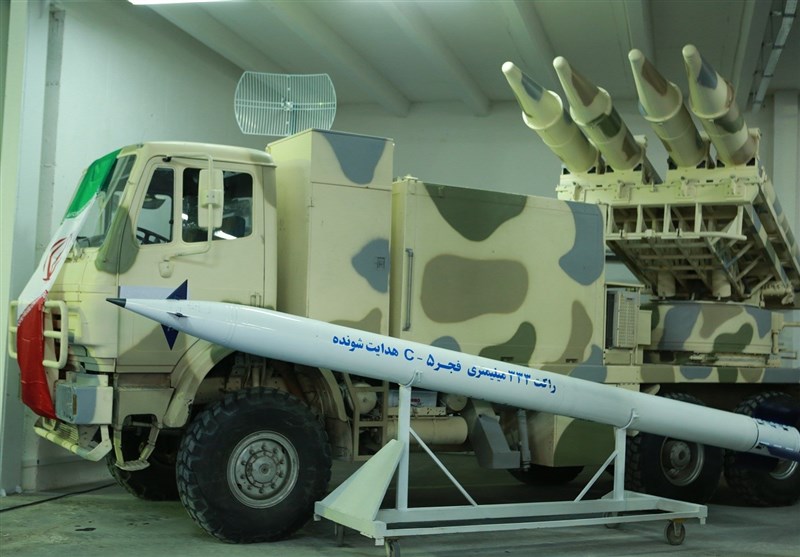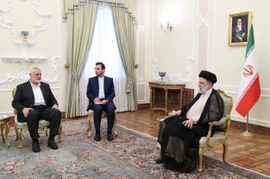Iran's Islamic Revolutionary Guard Corps (IRGC) Ground Force “successfully” tested a domestically manufactured ‘Fajr-5’ artillery rocket system with a thermobaric warhead.
"The new thermobaric warhead, which uses oxygen from the surrounding air to generate a high-temperature explosion, has increased the Iranian rocket’s destructive power,” Tasnim News Agency reported on May 7.
“The new warhead’s destructive power is reportedly 1.5 times greater than that of trinitrotoluene (TNT), enhancing the rocket’s blast radius and thermal effect,” the report added.
The thermobaric explosive’s lower sensitivity than TNT has made it a safer option in comparison with conventional warheads, it noted.
Fajr-5 is a 333 mm rocket, whose guided version, dubbed ‘Fajr-5C’, had been already delivered to the IRGC Ground Force units.
The warhead was developed by experts of the Research and Self-Sufficiency Jihad Organisation of the IRGC.
Thermobaric warheads were suitable "for the fight against terrorist groups in mountainous and impassable regions", where the terrorists construct shelters and trenches, according to the report.
Fajr-5 rockets came into the spotlight after they were given to Palestinian groups. In 2012, Hamas, the Palestinian Islamist organization that controls the Gaza Strip, used the Fajr-5 rockets against the Israeli Iron Dome air defense system. Tehran reportedly provides military and financial assistance to Palestinian groups such as Hamas and Islamic Jihad, which have fought against Israel in recent years to the tune of $100 million a year.
Tehran has been domestically producing new missiles despite American objections to Iran’s growing arsenal of ballistic weapons. The US has demanded that Iran halt its missile program amid rising tensions between the two countries.
Iranian Navy Commander Rear Admiral Shahram Irani said on May 6 that Iran's navy has armed its destroyers with Abu Mahdi cruise missiles with a range of 1,000 km. The country’s defence ministry has delivered the missiles to the navy and these would be unveiled soon.
Iran unveiled the Abu Mahdi missile in 2020. The surface-to-surface missile can be fired from coastal platforms and launchers.
Western governments worry that satellite launch systems incorporate technologies interchangeable with those used in ballistic missiles capable of delivering a nuclear warhead, while Iran has always denied this fact.
On May 6, Director of Iran Space Agency (ISA) Hassan Salariyeh detailed the satellites his country is planning to launch in the current year, saying that the ISA would receive and launch the second version of the Pars-1 satellite, which can be employed in scanning and imaging the Earth's surface.
He said that the Zafar-2 satellite was almost ready and was undergoing the final tests, and added that another satellite Tolou-4 would engage in higher-resolution imagery.
Salariyeh also said that the Nahid satellite will be launched to serve Iran's telecommunication sector, and the country would start designing and manufacturing the telecommunication satellite IranSat-1.
It is worth noting that Iran sent Pars-1 into space in February 2022. The previous version of the Tolou satellite was put into space in 2021. The first attempt to launch the Zafar satellite in 2020 failed because the carrier named Simorgh failed to attain the required speed.







 Azerbaijan officially unveiled the logo for the upcoming 29th session of the Conference of the Parties to the United Nations Framework Convention o...
Azerbaijan officially unveiled the logo for the upcoming 29th session of the Conference of the Parties to the United Nations Framework Convention o...
 The Islamic holy month of fasting, Ramadan comes to an end this week with the celebration of a joyous festival called Eid (meaning “festival” in Ar...
The Islamic holy month of fasting, Ramadan comes to an end this week with the celebration of a joyous festival called Eid (meaning “festival” in Ar...
 The number of evacuees from flooded areas in Kazakhstan has reached 97,852 people, including about 32,856 children since March 27.
The number of evacuees from flooded areas in Kazakhstan has reached 97,852 people, including about 32,856 children since March 27.



